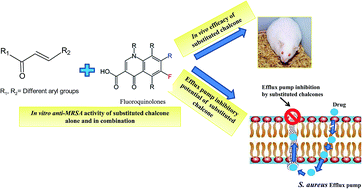In vitro and in vivo synergistic interaction of substituted chalcone derivatives with norfloxacin against methicillin resistant Staphylococcus aureus
Abstract
Thirty chalcone derivatives were synthesized via a base catalyzed Claisen Schmidt condensation and evaluated for their anti-methicillin-resistant Staphylococcus aureus (MRSA) activity alone and in combination with norfloxacin. Among these, 5 derivatives namely trans-3-(1H-indol-3-yl)-1-(4′-benzyloxyphenyl)-2-propen-1-one (2), 1-(4″-biphenyl)-3-(3′4′-dihydroxyphenyl)-2-propen-1-one (11), 1-(4″-hydroxy-3″-methylphenyl)3-(4′-hydroxyphenyl)-2-propen-1-one (14), 3-(4′-chlorophenyl)-1-(4″-hydroxyphenyl)2-propen-1-one (17), and LTG-oxime (27) showed significant antibacterial activity with MIC 12.5–50 µg mL−1 respectively. In combination studies, derivatives 2 and 14 significantly reduced the MIC of norfloxacin by up to 16 fold (FICI < 0.5), while derivatives 11, 17 and 27 reduced it by up to eight fold (FICI ≤ 0.5). Flow cytometry analysis results clearly indicated that derivatives 2 and 14 significantly promote the accumulation and inhibition of the Et-Br efflux, which was further validated through spectrofluorimeter using clinical isolate MRSA-ST2071. In systemically infected Swiss albino mice model, both the compounds significantly (P < 0.001, P < 0.01) lowered the systemic bacterial load in blood, liver, kidney, lung and spleen tissues. This study supports the promising use of chalcones in the development of economical antibacterial combinations.


 Please wait while we load your content...
Please wait while we load your content...